pifpaf
New member
In our contemporary world, music is everywhere, every time, brightens up and glorifies our everyday life. From the startups of the Silicon Valley up to the workshops of horology of our valleys, it is not uncommon to cross employees with earphones, which is a tolerated attitude because it seems that music increases productivity! Personally, when I am bustling about late at work, I listen to a hard piece so that I regain energy and inspiration.
Music, just like the Internet or modern medicine, is one of the greatest progresses of our civilization. Our ancestors did not know our happiness, music in the 19th century was so rare, and without our contemporary recording capacity they were dependent upon folk singers, only able to play intoxicating sonorities…
A singing bird is a complex machine where the constraints are quite different from those of a watch. In a watchmaking movement, we seek above all consistency so that an accurate count of the time can be provided whereas in a singing bird mechanism, it is more a matter of generating an important force to animate the bird and to produce the necessary air to produce an audible whistling.
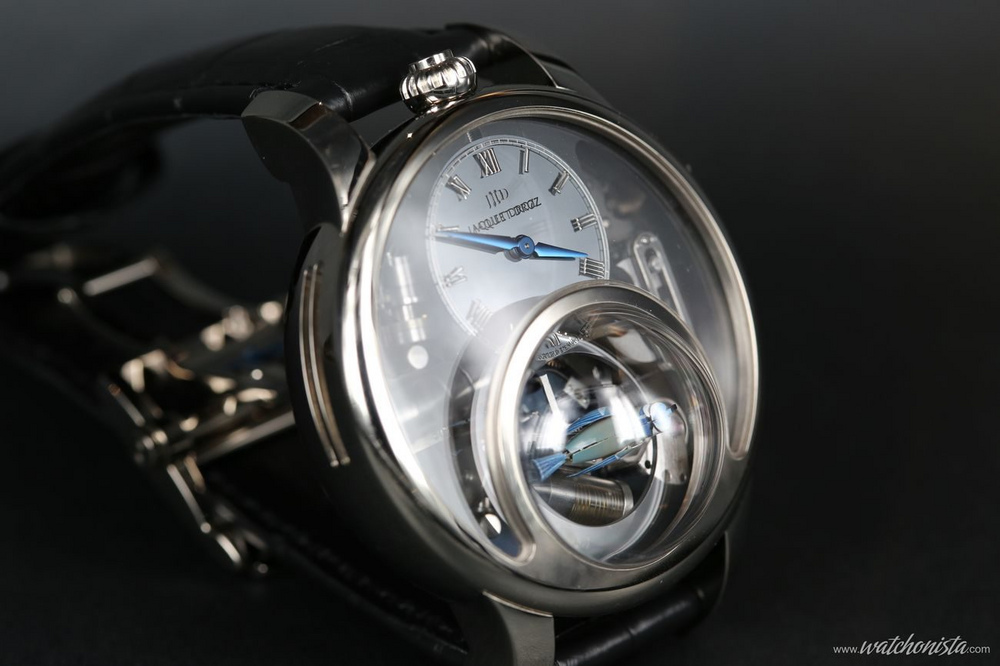
With the techniques of the 19th century, it was easier to obtain force (through heavier springs) than consistency (the quality of the springs, of the barrel, of the balance-springs has penalized chronometry for a long time). It was thus easier and more spectacular to produce a singing bird than a chronometer.
Since then, watchmaking craft has highly evolved, the progresses of metallurgy (elinvar…) and the new precision machines (milionometer…) have made it possible to rise to the double challenge of consistency and miniaturization.
Outshined by the appearance of gramophones at the start of the 20th Century, these singing birds have only marginally beneficiated from these technical progresses.
Jacquet Droz, which was one of the most prestigious mechanics Art house (automata, prostheses, singing birds and horology) wished to dust off the concept of the singing automaton while making it beneficiate from the last technological innovations and thus realizes a tour-de-force by presenting the first watch in history to embark a singing bird: the Charming Bird.

To attain this original musical complication, the Jaquet Droz watchmakers had to go from square one to palliate the relative lack of data about the singing birds automata and answer the miniaturization problematic imposed by the bulk of a wrist watch.
In a traditional singing bird automaton, we wind a lever that winds a complication barrel (like in a traditional minute-repetition) which will provide energy to two distinct parts: the animation of the automaton and the sound of the whistle.
A lamb leather bellows animated by the spring of the barrel provides air to the sound of the whistle. Therefore it is the spring that pumps air in the whistle, the sound is modulated (generally) by a kind of cylinder lined with sprockets; this will produce a melody. As for the bird, it is animated in various positions by a complex automaton system.
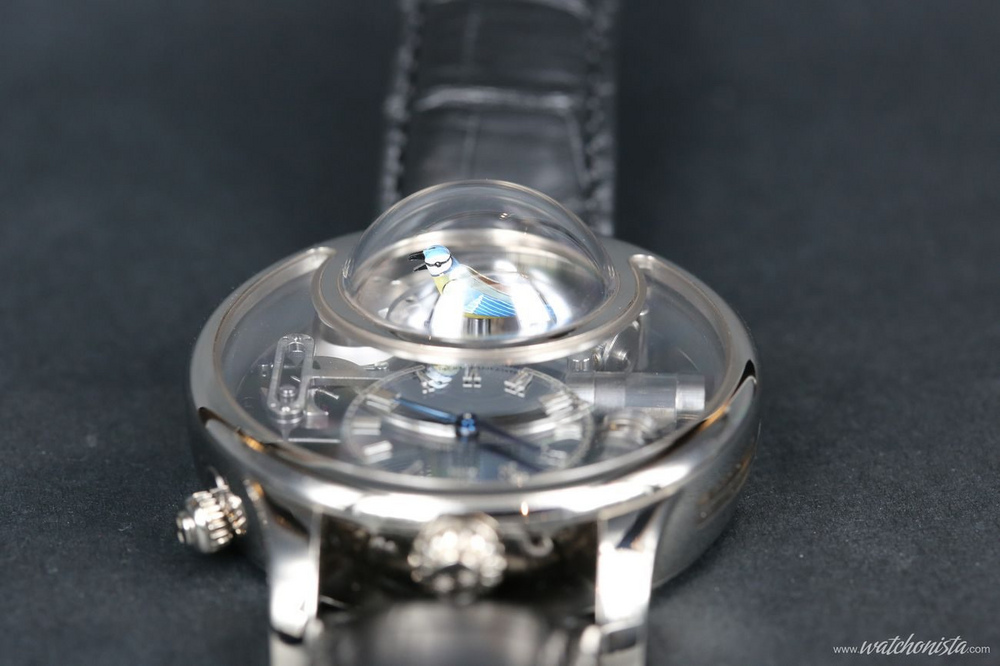
Often, in the mechanical field, the constraints are not proportional but exponential and if the mechanical parts are relatively easy to miniaturise today, it is not the case with the lamb leather part. Another obstacle that needs to be considered to the excessive miniaturization of the traditional system is that the product will be too weak to be audible for a human adult.
To rise to this challenge, the Jaquet Droz watchmakers are inspired by a piston of an internal combustion engine to obtain the same sonorous result as the traditional whistle. The compression ratio of this piston is very close to that of a sporty engine (approximately 1:10). Every organ: pump, air reservoirs and whistle are produced in sapphire in order to limit the frictions to the most.
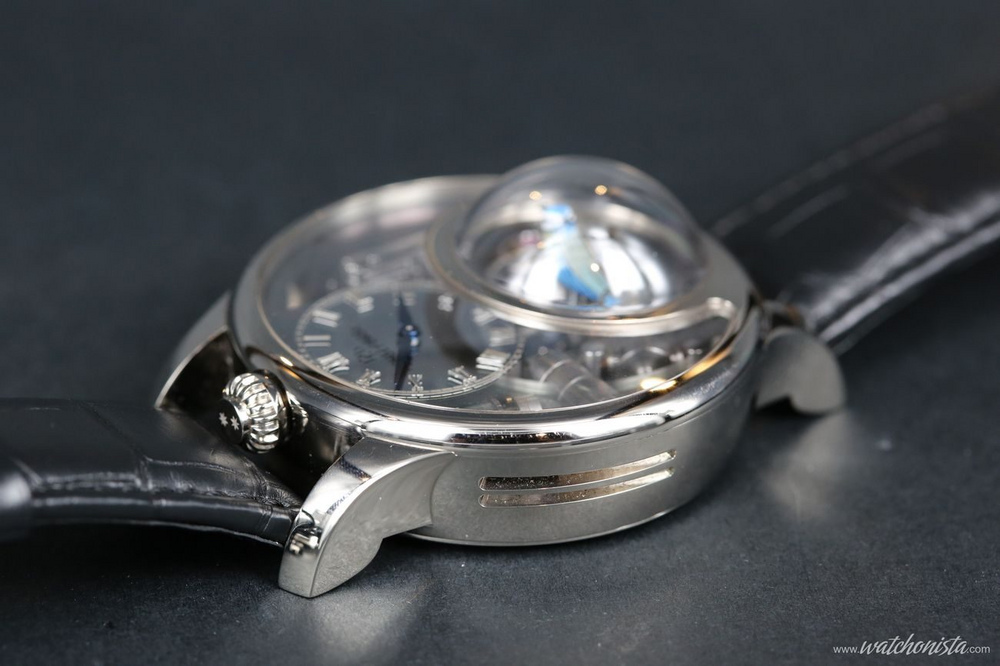
When the push-piece button, which is dedicated to the singing bird, is activated, the cam at 5h moves the piston, which crosses the watch from 3h to 9h. The pump fills the air reservoir, which supplies the melody to the whistle. The complication barrel feeds the automaton bird as much as the whistle: the mechanical ballet impresses while the ballet of the bird dancing to the rhythm of the whistling bewitches.
The bird, rather impressive, is arranged in a dome, which outsteps the surface of the sapphire glass. Such a procedure, destined to reduce the thickness of the case (thus from 22.80mm to 15.65mm), has already been seen in the case of escapement complications but never for a whistling automaton.
To facilitate the sound diffusion, the case has been pierced on the side. This opening was indispensable because contrary to a minute-repetition, there is no resonance phenomenon in the absence of a hammer indirectly hitting the structure of the watch.
The opening is equipped with a musical instrument membrane to prevent dust and light from entering the case. Careful about sudden dives in a pool, the not water-resistant case renders the watch’s mechanism vulnerable to water projections!
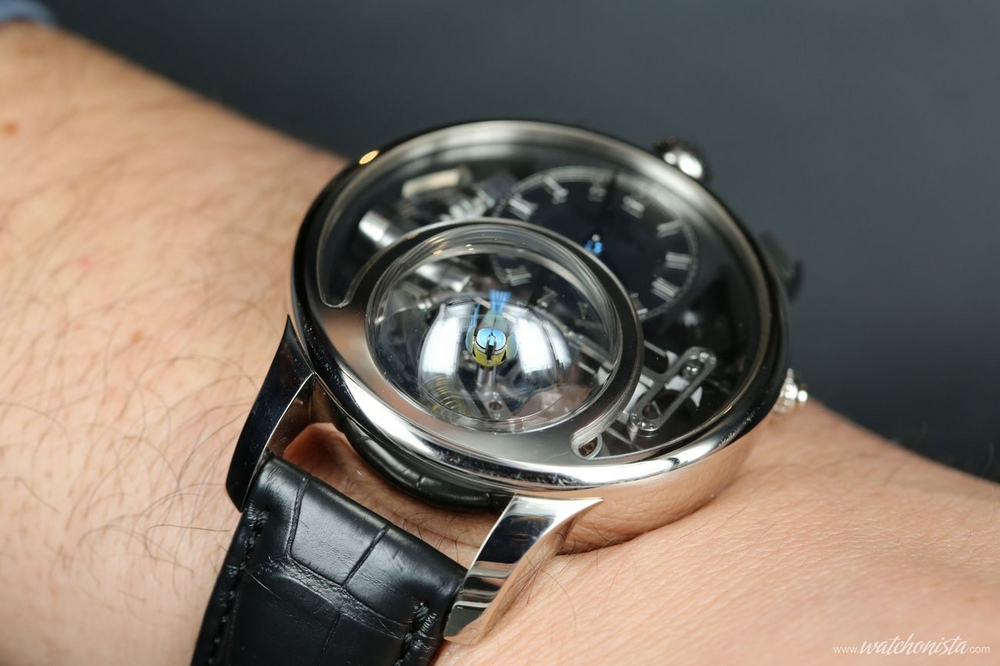
Aside from this specificity, the case is relatively classical, manufactured in white gold, it measures 47mm in diameter. The same concave form is found on the Bird Repeater (link), but where the Bird Repeater was ultra-coloured and more than vintage, the Charming Bird is very sober with its ruthenium finish, which gives the bridges an ultra-contemporary blackened look. Even the finish of the clock dial (at 12h) is very up-to-date.
The numbers seem to levitate upon the dial but contrarily to what could have been seen at Hautlence some years ago, they are not glued on the inside of the glass sapphire. The silver dial is covered with a sapphire plate; the indexes are directly integrated to the latter through a galvanic growth. A novelty? If the bird remains painted to the colours of the **** bird so dear to Jaquet Droz, their lacquered finish is stylistically at the limit of art deco, a mini revolution if we consider that in the great tradition the singing birds are covered with real birds’ feathers.
Between the dome borrowed from the world of independent watchmaking, the blackened finish of the bridges, the indices in levitation and the streamlined **** bird, this watch is a radical aesthetic turn for Jaquet Droz. There had already been somewhat offbeat watches, in particular with ceramic cases, but no product was as futuristic.
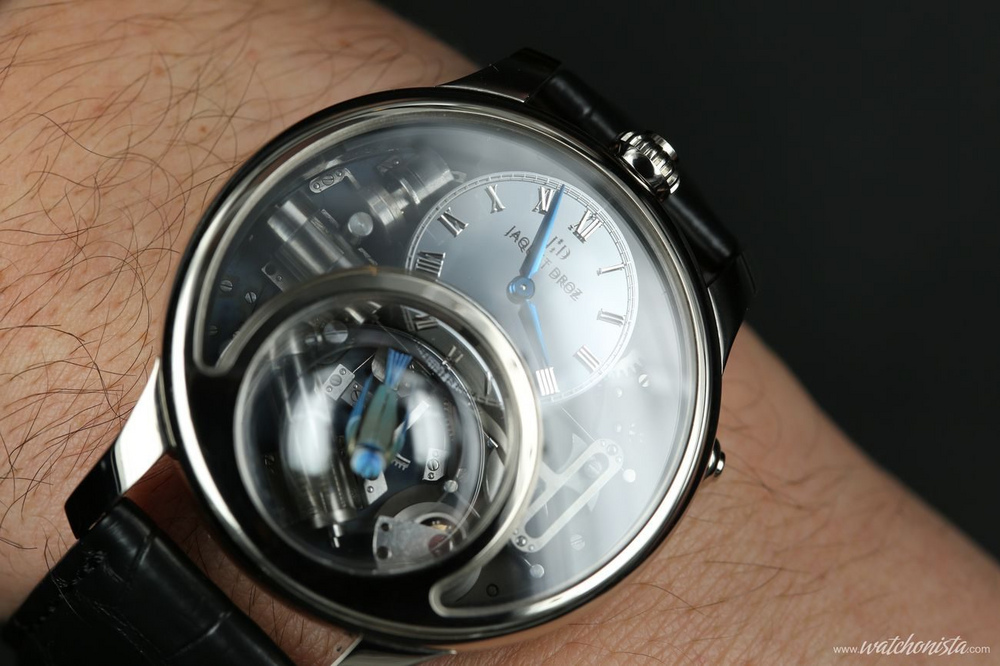
Subjectively, the Charming Bird is a beautiful watch. Objectively, if you think of the success of the Lange’s Zeitwerk Luminous (a contemporary watch in a classic range) the latest high-complication coming from the Jaquet Droz workshops is most likely destined to great success.
But Jaquet Droz, which celebrates the 275 years of its establishment this year, goes further by signing a completely unique complication, a major watch in the history of musical complications. Its only problem is its price: approximately 400k CHF. Both the going rate and the number of copies (28) reserve it to an elite of collectors. With a similar tariff and number of copies the Bird Repeater is already sold out.
To less fortunate watch passionate, Jaquet Droz proposes other pieces:
Perpetual Calendar Eclipse:
Basic mechanical horology, it is quite outdated, any smartphone gives a more accurate time than the most precise of the mechanical watches.
But we can go further in the hunt for chimeras with a Perpetual Calendar (quantième perpetuel in French = QP). This indeed requires winding and constant settings (summer / winter time) to be truly perpetual.
The QP, this is one of the dandiest exercises of the mechanical watch, every prestigious horology house has to have its QP.
Today, Jaquet Droz presents a new vision of the QP, teeming with poetry and theatricality: the Perpetual Calendar Eclipse. The watch is slightly concave in red gold, it is 43 by 13.2mm in height, the proportions are almost perfect; it is worth mentioning that with its large dial opening and ivory grand feu enamel dial it seems a little large on the wrist.
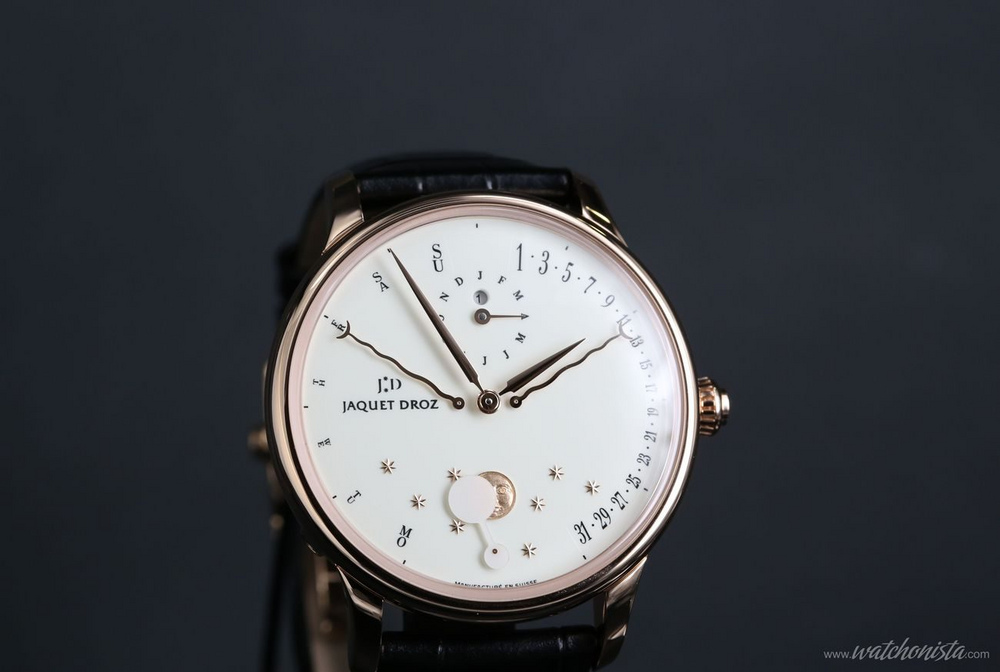
There is a black version (made in Onyx), which seems a little more compact, possibly to be preferred for smaller wrists.
The watch is powered by an automatic modular calibre with double barrel providing 68h of power reserve for a frequency of 28 800 a/h ... The module, seen in the Swatch Group, is here slightly modified to provide this exclusive arrangement to this QP Eclipse.
The layout of the dial is very original but very readable: the exercise with so many indications is not so easy in a PC. It is on the left half of the dial that the day of the week is indicated; on the right side, the indication of the date, the month at 12h. Only flaw, the aperture of the leap year, all the indications are made by hands and it is somewhat a shame to disturb the harmony with an indication by aperture. We could have found the leap year on the back for example.
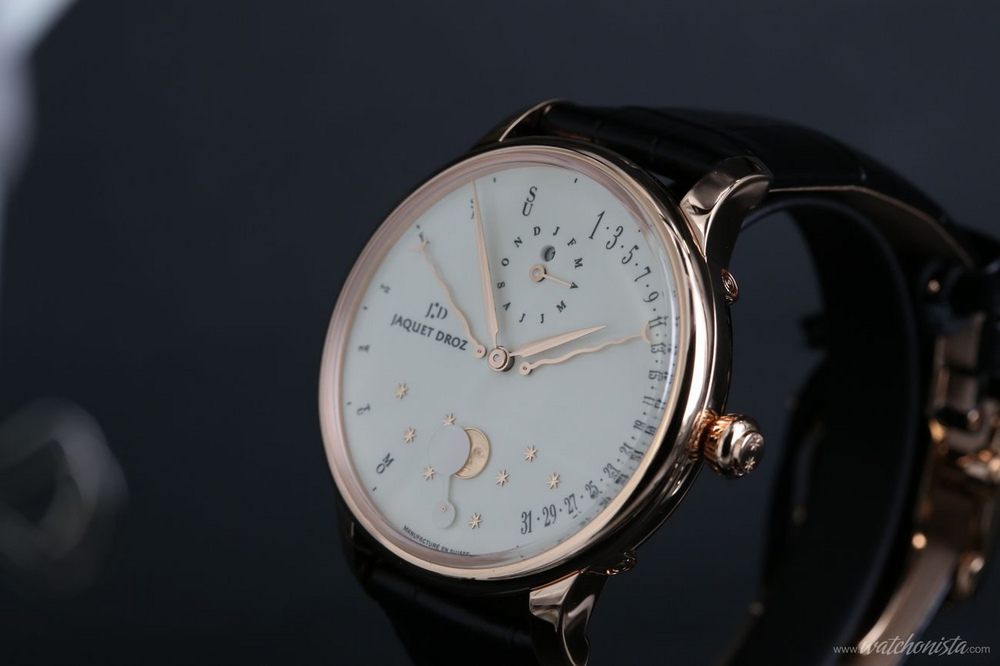
The climax of this piece is indeed on the moon phase at 6 o'clock. As on the original eclipse, the moon levels the dial and a pivoting disc will hide it according to the phases of the lunar orb. The assembly formed by the disk arm and the moon is inevitably reminiscent of a Venetian mask mounted on arms ... With the ballet of retrograde indications and the stars, the universe of classical theater is suggested in a very elegant way.
If we put aside the incongruous leap year aperture, it is one of the finest Perpetual Calendar in the market: readability, size, layout, everything is perfect. The great strength of this watch is that all the space is filled with the intelligence of a French garden, the minute hands run until the flange and despite the large size of the needles, the indications overlap very little, which allows to save one or two millimeters in box height.
The prices, high, are not delusional for this type of complication with this level of finish: 56'200 CHF.
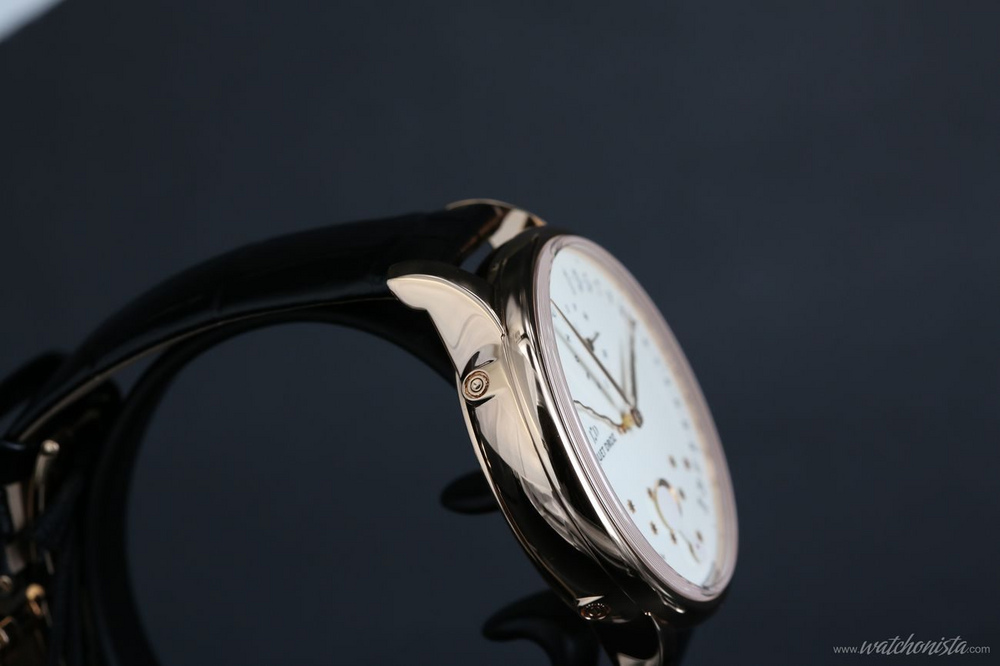
Grande Heure GMT :
If we claim to be a purist, how can we not mention the mono-hands? At the beginning of the pocket watchmaking, in the XVIIIth century, was the mono hand.
Indeed, at that time the mono hand had several advantages. First of all the alloys of balance springs at that time were not very consistent. This conditioned the levels of accuracy of about a quarter of an hour. The large cases, allowed in addition to have a precise enough railway. Finally, a mono hand barrel avoided friction, which was not superfluous given that the levels of tolerance were quite high at that time…
Today, the mono hands are one of the most serious tributes to the beginning of portable watchmaking. Jaquet Droz already made a watch of this type. But today, the idea is to produce a double mono hand indicating two timezones !
The Crande Heure GMT is a watch of 43mm for 11mm, animated, as the QP Eclipse, by a Jaquet Droz calibre based on the Piguet 1150. The 1150 is a double barrel calibre of 11” ½ lines for 100 hours of power reserve for 21600 v/h.
At Jaquet Droz the frequency is pushed to 28800 v/h and the power reserve accordingly reduced to 68 hours.
The particularity of its complication is to benefit from a large double time without minutes. Which makes it one of the most precise GMT on the market in the absence of friction of the minute hand.
The two hands of hours form a compass, which is obviously a nod to vintage maritime navigation. This exercise is obviously more a tribute than a re-edition of a piece, which existed, but the atmosphere is here. We believe, we have fun with this watch!
To take the exercise even further Jaquet Droz could enlarge the size of the case to enlarge the railway and facilitate the reading of the hour, to the nearest minute.
The watch will be charged CHF 27,150 for the gold version.
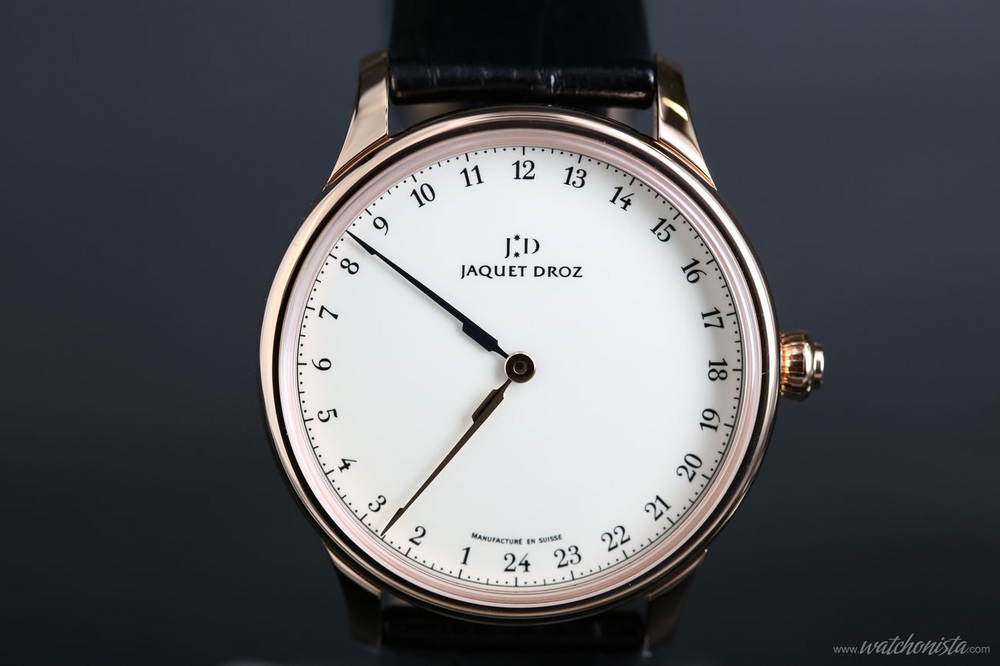
Music, just like the Internet or modern medicine, is one of the greatest progresses of our civilization. Our ancestors did not know our happiness, music in the 19th century was so rare, and without our contemporary recording capacity they were dependent upon folk singers, only able to play intoxicating sonorities…
A singing bird is a complex machine where the constraints are quite different from those of a watch. In a watchmaking movement, we seek above all consistency so that an accurate count of the time can be provided whereas in a singing bird mechanism, it is more a matter of generating an important force to animate the bird and to produce the necessary air to produce an audible whistling.

With the techniques of the 19th century, it was easier to obtain force (through heavier springs) than consistency (the quality of the springs, of the barrel, of the balance-springs has penalized chronometry for a long time). It was thus easier and more spectacular to produce a singing bird than a chronometer.
Since then, watchmaking craft has highly evolved, the progresses of metallurgy (elinvar…) and the new precision machines (milionometer…) have made it possible to rise to the double challenge of consistency and miniaturization.
Outshined by the appearance of gramophones at the start of the 20th Century, these singing birds have only marginally beneficiated from these technical progresses.
Jacquet Droz, which was one of the most prestigious mechanics Art house (automata, prostheses, singing birds and horology) wished to dust off the concept of the singing automaton while making it beneficiate from the last technological innovations and thus realizes a tour-de-force by presenting the first watch in history to embark a singing bird: the Charming Bird.

To attain this original musical complication, the Jaquet Droz watchmakers had to go from square one to palliate the relative lack of data about the singing birds automata and answer the miniaturization problematic imposed by the bulk of a wrist watch.
In a traditional singing bird automaton, we wind a lever that winds a complication barrel (like in a traditional minute-repetition) which will provide energy to two distinct parts: the animation of the automaton and the sound of the whistle.
A lamb leather bellows animated by the spring of the barrel provides air to the sound of the whistle. Therefore it is the spring that pumps air in the whistle, the sound is modulated (generally) by a kind of cylinder lined with sprockets; this will produce a melody. As for the bird, it is animated in various positions by a complex automaton system.

Often, in the mechanical field, the constraints are not proportional but exponential and if the mechanical parts are relatively easy to miniaturise today, it is not the case with the lamb leather part. Another obstacle that needs to be considered to the excessive miniaturization of the traditional system is that the product will be too weak to be audible for a human adult.
To rise to this challenge, the Jaquet Droz watchmakers are inspired by a piston of an internal combustion engine to obtain the same sonorous result as the traditional whistle. The compression ratio of this piston is very close to that of a sporty engine (approximately 1:10). Every organ: pump, air reservoirs and whistle are produced in sapphire in order to limit the frictions to the most.

When the push-piece button, which is dedicated to the singing bird, is activated, the cam at 5h moves the piston, which crosses the watch from 3h to 9h. The pump fills the air reservoir, which supplies the melody to the whistle. The complication barrel feeds the automaton bird as much as the whistle: the mechanical ballet impresses while the ballet of the bird dancing to the rhythm of the whistling bewitches.
The bird, rather impressive, is arranged in a dome, which outsteps the surface of the sapphire glass. Such a procedure, destined to reduce the thickness of the case (thus from 22.80mm to 15.65mm), has already been seen in the case of escapement complications but never for a whistling automaton.
To facilitate the sound diffusion, the case has been pierced on the side. This opening was indispensable because contrary to a minute-repetition, there is no resonance phenomenon in the absence of a hammer indirectly hitting the structure of the watch.
The opening is equipped with a musical instrument membrane to prevent dust and light from entering the case. Careful about sudden dives in a pool, the not water-resistant case renders the watch’s mechanism vulnerable to water projections!

Aside from this specificity, the case is relatively classical, manufactured in white gold, it measures 47mm in diameter. The same concave form is found on the Bird Repeater (link), but where the Bird Repeater was ultra-coloured and more than vintage, the Charming Bird is very sober with its ruthenium finish, which gives the bridges an ultra-contemporary blackened look. Even the finish of the clock dial (at 12h) is very up-to-date.
The numbers seem to levitate upon the dial but contrarily to what could have been seen at Hautlence some years ago, they are not glued on the inside of the glass sapphire. The silver dial is covered with a sapphire plate; the indexes are directly integrated to the latter through a galvanic growth. A novelty? If the bird remains painted to the colours of the **** bird so dear to Jaquet Droz, their lacquered finish is stylistically at the limit of art deco, a mini revolution if we consider that in the great tradition the singing birds are covered with real birds’ feathers.
Between the dome borrowed from the world of independent watchmaking, the blackened finish of the bridges, the indices in levitation and the streamlined **** bird, this watch is a radical aesthetic turn for Jaquet Droz. There had already been somewhat offbeat watches, in particular with ceramic cases, but no product was as futuristic.

Subjectively, the Charming Bird is a beautiful watch. Objectively, if you think of the success of the Lange’s Zeitwerk Luminous (a contemporary watch in a classic range) the latest high-complication coming from the Jaquet Droz workshops is most likely destined to great success.
But Jaquet Droz, which celebrates the 275 years of its establishment this year, goes further by signing a completely unique complication, a major watch in the history of musical complications. Its only problem is its price: approximately 400k CHF. Both the going rate and the number of copies (28) reserve it to an elite of collectors. With a similar tariff and number of copies the Bird Repeater is already sold out.
To less fortunate watch passionate, Jaquet Droz proposes other pieces:
Perpetual Calendar Eclipse:
Basic mechanical horology, it is quite outdated, any smartphone gives a more accurate time than the most precise of the mechanical watches.
But we can go further in the hunt for chimeras with a Perpetual Calendar (quantième perpetuel in French = QP). This indeed requires winding and constant settings (summer / winter time) to be truly perpetual.
The QP, this is one of the dandiest exercises of the mechanical watch, every prestigious horology house has to have its QP.
Today, Jaquet Droz presents a new vision of the QP, teeming with poetry and theatricality: the Perpetual Calendar Eclipse. The watch is slightly concave in red gold, it is 43 by 13.2mm in height, the proportions are almost perfect; it is worth mentioning that with its large dial opening and ivory grand feu enamel dial it seems a little large on the wrist.

There is a black version (made in Onyx), which seems a little more compact, possibly to be preferred for smaller wrists.
The watch is powered by an automatic modular calibre with double barrel providing 68h of power reserve for a frequency of 28 800 a/h ... The module, seen in the Swatch Group, is here slightly modified to provide this exclusive arrangement to this QP Eclipse.
The layout of the dial is very original but very readable: the exercise with so many indications is not so easy in a PC. It is on the left half of the dial that the day of the week is indicated; on the right side, the indication of the date, the month at 12h. Only flaw, the aperture of the leap year, all the indications are made by hands and it is somewhat a shame to disturb the harmony with an indication by aperture. We could have found the leap year on the back for example.

The climax of this piece is indeed on the moon phase at 6 o'clock. As on the original eclipse, the moon levels the dial and a pivoting disc will hide it according to the phases of the lunar orb. The assembly formed by the disk arm and the moon is inevitably reminiscent of a Venetian mask mounted on arms ... With the ballet of retrograde indications and the stars, the universe of classical theater is suggested in a very elegant way.
If we put aside the incongruous leap year aperture, it is one of the finest Perpetual Calendar in the market: readability, size, layout, everything is perfect. The great strength of this watch is that all the space is filled with the intelligence of a French garden, the minute hands run until the flange and despite the large size of the needles, the indications overlap very little, which allows to save one or two millimeters in box height.
The prices, high, are not delusional for this type of complication with this level of finish: 56'200 CHF.

Grande Heure GMT :
If we claim to be a purist, how can we not mention the mono-hands? At the beginning of the pocket watchmaking, in the XVIIIth century, was the mono hand.
Indeed, at that time the mono hand had several advantages. First of all the alloys of balance springs at that time were not very consistent. This conditioned the levels of accuracy of about a quarter of an hour. The large cases, allowed in addition to have a precise enough railway. Finally, a mono hand barrel avoided friction, which was not superfluous given that the levels of tolerance were quite high at that time…
Today, the mono hands are one of the most serious tributes to the beginning of portable watchmaking. Jaquet Droz already made a watch of this type. But today, the idea is to produce a double mono hand indicating two timezones !
The Crande Heure GMT is a watch of 43mm for 11mm, animated, as the QP Eclipse, by a Jaquet Droz calibre based on the Piguet 1150. The 1150 is a double barrel calibre of 11” ½ lines for 100 hours of power reserve for 21600 v/h.
At Jaquet Droz the frequency is pushed to 28800 v/h and the power reserve accordingly reduced to 68 hours.
The particularity of its complication is to benefit from a large double time without minutes. Which makes it one of the most precise GMT on the market in the absence of friction of the minute hand.
The two hands of hours form a compass, which is obviously a nod to vintage maritime navigation. This exercise is obviously more a tribute than a re-edition of a piece, which existed, but the atmosphere is here. We believe, we have fun with this watch!
To take the exercise even further Jaquet Droz could enlarge the size of the case to enlarge the railway and facilitate the reading of the hour, to the nearest minute.
The watch will be charged CHF 27,150 for the gold version.



